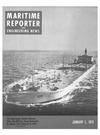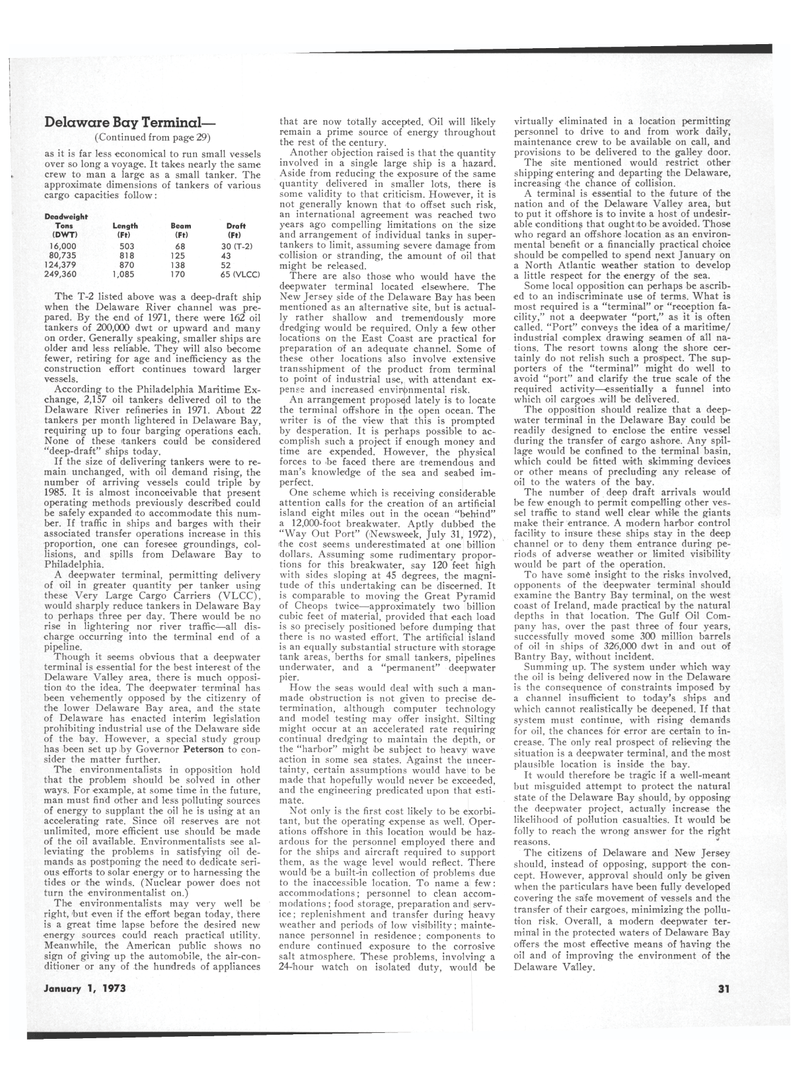
Page 29: of Maritime Reporter Magazine (January 1973)
Read this page in Pdf, Flash or Html5 edition of January 1973 Maritime Reporter Magazine
Delaware Bay Terminal— (Continued from page 29) as it is far less economical to run small vessels over so long a voyage. It takes nearly the same crew to man a large as a small tanker. The approximate dimensions of tankers of various cargo capacities follow:
Deadweight'
Tons Length Beam Draft (DWT) (Ft) (Ft) (Ft) 16,000 503 68 30 (T-2) 80,735 818 125 43 124,379 870 138 52 249,360 1,085 170 65 (VLCC)
The T-2 listed above was a deep-draft ship when the Delaware River channel was pre- pared. By the end of 1971, there were 162 oil tankers of 200,000 dwt or upward and many on order. Generally speaking, smaller ships are older and less reliable. They will also become fewer, retiring for age and inefficiency as the construction effort continues toward larger vessels.
According to the Philadelphia Maritime Ex- change, 2,157 oil tankers delivered oil to the
Delaware River refineries in 1971. About 22 tankers per month lightered in Delaware Bay, requiring up to four barging operations each.
None of these bankers could be considered "deep-draft" ships today.
If the size of delivering tankers were to re-
main unchanged, with oil demand rising, the
number of arriving vessels could triple by
1985. It is almost inconceivable that present
operating methods previously described could
be safely expanded Philadelphia.
A deepwater terminal, permitting delivery
of oil in greater quantity per tanker using
these Very Large Cargo Carriers (VLCC),
would sharply reduce tankers in Delaware Bay
to perhaps three per day. There would be no
rise in lightering nor river traffic—all dis-
charge occurring into the terminal end of a
pipeline.
Though it seems obvious that a deepwater
terminal is essential for the best interest of the
Delaware Valley area, there is much opposi-
tion ito the idea. The deepwater terminal has
been vehemently opposed by the citizenry of
the lower Delaware Bay area, and the state
of Delaware has enacted interim legislation
prohibiting industrial use of the Delaware side
of the bay. However, a special study group
has been set up by Governor Peterson to con-
sider the matter further.
The environmentalists in opposition hold
that the problem should be solved in other
ways. For example, at some time in the future,
man must find other and less polluting sources
of energy to supplant the oil he is using at an
accelerating rate. Since oil reserves are not
unlimited, more efficient use should be made
of the oil available. Environmentalists see al-
leviating the problems in satisfying oil de-
mands as postponing the need to dedicate seri-
ous efforts to solar energy or to harnessing the
tides or the winds. (Nuclear power does not
turn the environmentalist on.)
The environmentalists may very well be
right, but even if the effort began today, there
is a great time lapse before the desired new
energy sources could reach practical utility.
Meanwhile, the American public shows no
sign of giving up the automobile, the air-con-
ditioner or any of the hundreds of appliances
that are now totally accepted. Oil will likely
remain a prime source of energy throughout
the rest of the century.
Another objection raised is that the quantity
involved in a single large ship is a hazard.
Aside from reducing the exposure of the same
quantity delivered in smaller lots, there is
some validity to that criticism. However, it is
not generally known that to offset such risk,
an international agreement was reached two
years ago compelling limitations on the size
and arrangement of individual tanks in super-
tankers to limit, assuming severe damage from
collision or stranding, the amount of oil that
might be released.
There are also those who would have the
deepwater terminal located elsewhere. The
New Jersey side of the Delaware Bay has been
mentioned as an alternative site, but is actual-
ly rather shallow and tremendously more
dredging would be required. Only a few other
locations on the East Coast are practical for
preparation of an adequate channel. Some of
these other locations also involve extensive
transshipment of the product from terminal
to point of industrial use, with attendant ex-
pense and increased environmental risk.
An arrangement proposed lately is to locate
the terminal offshore in tjie open ocean. The
writer is of the view that this is prompted
by desperation. It is perhaps possible to ac-
complish such a project if enough money and
time are expended. However, the physical
forces to be faced there are 'tremendous and
man's knowledge of the sea and seabed im-
perfect.
One scheme which is receiving considerable
attention calls for the creation of an artificial
island eight miles out in the ocean "behind"
a 12,000-foot breakwater. Aptly dubbed the
"Way Out Port" (Newsweek, July 31, 1972),
the cost seems underestimated at one billion
dollars. Assuming some rudimentary propor-
tions for this breakwater, say 120 feet high
with sides sloping at 45 degrees, the magni-
tude of this undertaking can be discerned. It
is comparable to moving the Great Pyramid
of Cheops twice—approximately two billion
cubic feet of material, provided that each load
is so precisely positioned before dumping that
there is no wasted effort. The artificial island
is an equally substantial structure with storage
tank areas, berths for small tankers, pipelines
underwater, and a "permanent" deepwater
pier.
How the seas would deal with such a man-
made obstruction is not given to precise de-
termination, although computer technology
and model testing may offer insight. Silting
might occur at an accelerated rate requiring
continual dredging to maintain the depth, or
the "harbor" might be subject to heavy wave
action in some sea states. Against the uncer-
tainty, certain assumptions would have to be
made that hopefully would never be exceeded,
and the engineering predicated upon that esti-
mate.
Not only is the first cost likely to be exorbi-
tant, but the operating expense as well. Oper-
ations offshore in this location would be haz-
ardous for the personnel employed there and
for the ships and aircraft required to support
them, as the wage level would reflect. There
would be a built-in collection of problems due
to the inaccessible location. To name a few:
accommodations; personnel to clean accom-
modations; food storage, preparation and serv-
ice ; replenishment and transfer during heavy
weather and periods of low visibility; mainte-
nance personnel in residence; components to
endure continued exposure to the corrosive
salt atmosphere. These problems, involving a
24-hour watch on isolated duty, would be
virtually eliminated in a location permitting
personnel to drive to and from work daily,
maintenance crew to be available on call, and
provisions to be delivered to the galley door.
The site mentioned would restrict other
shipping entering and departing the Delaware,
increasing 'the chance of collision.
A terminal is essential to the future of the
nation and of the Delaware Valley area, but
to put it offshore is to invite a host of undesir-
able conditions that ought fto be avoided. Those
who regard an offshore location as an environ-
mental benefit or a financially practical choice
should be compelled to spend next January on
a North Atlantic weather station to develop
a little respect for the energy of the sea.
Some local opposition can perhaps be ascrib-
ed to an indiscriminate use of terms. What is
most required is a "terminal" or "reception fa-
cility," not a deepwater "port," as it is often
called. "Port" conveys the idea of a maritime/
industrial complex drawing seamen of all na-
tions. The resort towns along the shore cer-
tainly do not relish such a prospect. The sup-
porters of the "terminal" might do well to
avoid "port" and clarify the true scale of the
required activity—essentially a funnel into
which oil cargoes -will be delivered.
The opposition should realize that a deep-
water terminal in the Delaware Bay could be
readily designed to enclose the entire vessel
during the transfer of cargo ashore. Any spil-
lage would be confined to the terminal basin,
which could be fitted with skimming devices
or other means of precluding any release of
oil to the waters of the bay.
The number of deep draft arrivals would
be few enough to permit compelling other ves-
sel traffic to stand well clear while the giants
make their entrance. A modern harbor control
facility to insure these ships stay in the deep
channel or to deny them entrance during pe-
riods of adverse weather or limited visibility
would be part of the operation.
To have some insight to the risks involved,
opponents of the deepwater terminal should
examine the Bantry Bay terminal, on the west
coast of Ireland, made practical by the natural
depths in that location. The Gulf Oil Com-
pany has, over the past three of four years,
successfully moved some 300 million barrels
of oil in ships of 326,000 dwt in and out of
Bantry Bay, without incident.
Summing up. The system under which way
the oil is being delivered now in the Delaware
is the consequence of constraints imposed by
a channel insufficient to today's ships and
which cannot realistically be deepened. If that
system must continue, with rising demands
for oil, the chances for error are certain to in-
crease. The only real prospect of relieving the
situation is a deepwater terminal, and the most
plausible location is inside the bay.
It would therefore be tragic if a well-meant
but misguided attempt to protect the natural
state of the Delaware Bay should, by opposing
the deepwater project, actually increase the
likelihood of pollution casualties. It would be
folly to reach the wrong answer for the right
reasons.
The citizens of Delaware and New Jersey
should, instead of opposing, support the con-
cept. However, approval should only be given
when the particulars have been fully developed
covering the safe movement of vessels and the
transfer of their cargoes, minimizing the pollu-
tion risk. Overall, a modern deepwater ter-
minal in the protected waters of Delaware Bay
offers the most effective means of having the
oil and of improving the environment of the
Delaware Valley.
January 1, 1973 31

 28
28

 30
30
